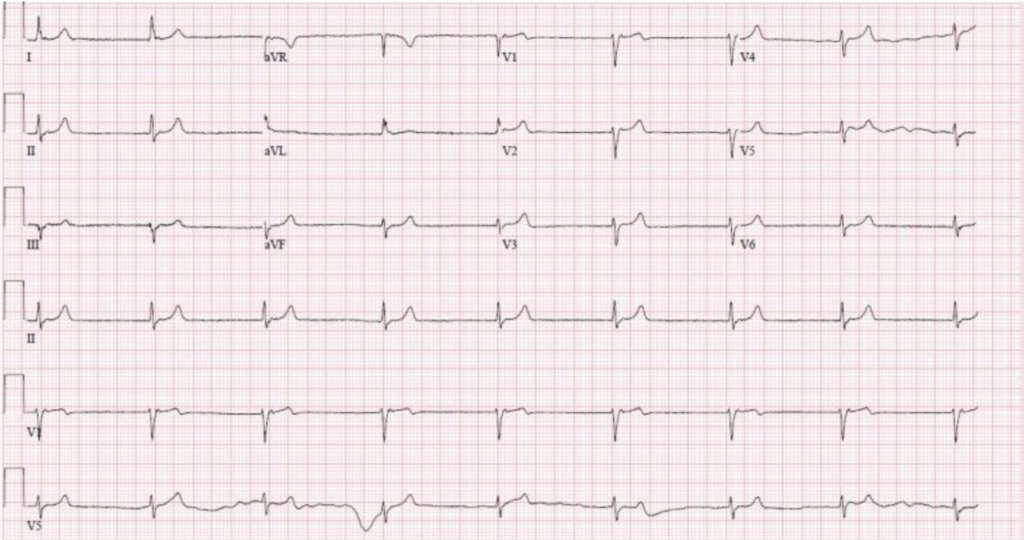Case Presentation
History
Mrs. Smith, a 55-year-old female, presented with a sudden onset of severe pain in her left ear, accompanied by facial weakness and difficulty closing her left eye. She reported a recent episode of shingles on her left forehead.
- No history of trauma to the head or face.
- No recent travel to areas with endemic infectious diseases.
- No history of recent medication changes or exposure to neurotoxic substances.
Comorbidities
- Hypertension: Mrs. Smith has a history of well-controlled hypertension, managed with lifestyle modifications and medication.
- Diabetes Mellitus: Mrs. Smith is diagnosed with type 2 diabetes mellitus, managed with oral hypoglycemic agents.
General Examination
- Pulse: 88 bpm
- Blood Pressure: 130/80 mmHg
- Respiratory Rate: 18 breaths per minute
- SpO2: 98% on room air
- Afebrile
Systemic Examination
- Respiratory System: Clear breath sounds bilaterally
- Cardiovascular System: Regular rhythm without murmurs or gallops
- Central Nervous System (CNS):
- Mental Status: Alert and oriented to person, place, and time
- Cranial Nerves:
- Cranial Nerve I (Olfactory): Intact
- Cranial Nerve II (Optic): Visual acuity 20/20 bilaterally
- Cranial Nerves III, IV, VI (Oculomotor, Trochlear, Abducens): Pupils equal and reactive to light, extraocular movements intact
- Cranial Nerve V (Trigeminal): Decreased sensation to light touch on the left side of the face
- Cranial Nerve VII (Facial): Left-sided facial weakness, inability to close left eye, decreased taste sensation on the left anterior two-thirds of the tongue
- Cranial Nerves VIII (Vestibulocochlear): Decreased hearing on the left side
- Cranial Nerves IX, X (Glossopharyngeal, Vagus): Normal palate elevation, intact gag reflex
- Cranial Nerves XI (Accessory): Normal shoulder shrug strength
- Cranial Nerve XII (Hypoglossal): Tongue protrudes midline without deviation
- Motor Examination: Normal muscle tone and strength in all four limbs
- Sensory Examination: Decreased sensation to light touch on the left side of the face
- Reflexes: Deep tendon reflexes (DTRs) normal bilaterally
Labs
- Complete Blood Count (CBC): Hemoglobin 12.5 g/dL, White Blood Cell Count (WBC) 9,500/mm3
- Liver Function Tests (LFT): Alanine transaminase (ALT) 28 U/L, Aspartate transaminase (AST) 32 U/L
- Renal Function Tests (RFT): Blood Urea Nitrogen (BUN) 14 mg/dL, Creatinine 0.8 mg/dL
- C-reactive Protein (CRP): Elevated (CRP 20 mg/L)
- Erythrocyte Sedimentation Rate (ESR): Elevated (ESR 40 mm/h)
- Serology: Varicella-zoster virus IgM positive
Radiology
MRI of the brain with contrast revealed enhancement of the left facial nerve, confirming facial nerve involvement.
Diagnosis
Based on the clinical presentation, examination findings, and diagnostic tests, Mrs. Smith was diagnosed with Ramsay Hunt Syndrome. The presence of vesicular rash in the ear canal, facial weakness, and history of recent shingles were indicative of VZV reactivation.
Overview:
Ramsay Hunt Syndrome (RHS) is a rare neurological disorder caused by the Varicella-zoster virus (VZV), the same virus responsible for chickenpox and shingles. This syndrome is characterized by severe pain, facial paralysis, and sometimes hearing loss.

Treatment
Antiviral Therapy
Mrs. Smith was started on a course of oral antiviral medication, such as acyclovir or valacyclovir, to inhibit viral replication and reduce the severity and duration of symptoms.
Corticosteroids
To reduce inflammation and swelling of the affected facial nerve, corticosteroids such as prednisone were prescribed.
Pain Management
Mrs. Smith received analgesics to alleviate the excruciating pain associated with RHS, which can be debilitating.
Prognosis
The prognosis for Ramsay Hunt Syndrome varies depending on the severity of symptoms and the timeliness of treatment. Prompt initiation of antiviral therapy and supportive care can improve outcomes. However, some patients may experience long-term complications such as residual facial weakness or hearing loss.
Conclusion
Ramsay Hunt Syndrome is a rare but potentially debilitating condition caused by reactivation of the Varicella-zoster virus. Timely recognition and appropriate management are essential for optimal outcomes. Through comprehensive case presentations, accurate diagnosis, and targeted treatment strategies, healthcare professionals can effectively manage patients with Ramsey Hunt Syndrome, thereby improving their quality of life.
Read More:
